Ear training. A vital component for any musician, but it can cause students to sigh, roll their eyes, and procrastinate. “Can we do something else instead? Anything else?”
Wondering how to make ear training more fun and enjoyable? Games!
Ear training. A vital component for any musician, but it can cause students to sigh, roll their eyes, and procrastinate. “Can we do something else instead? Anything else?”
Wondering how to make ear training more fun and enjoyable? Games!
Table Of Contents
We’re pianists. What do we need ear training for? Press a key, the sound comes out. Put the right finger numbers on the right keys at the right time and the right music magically appears.
But have you ever had one of those students that could stubbornly play through a whole piece with fingers in the wrong position, seemingly oblivious to the hideous dissonance produced?
Among the most profound achievements of humanity, the piano keyboard manifests the inner secrets of music theory – both visually and tactilely – better than any instrument yet invented. Yet the mechanical nature of the piano removes us from the intimacy of producing the sound (as compared to wind and string instruments) and from the responsibility of intonation.
(Just blame the piano tuner!)
While it is perfectly possible to operate our music machines without putting much attention on what they actually sound like, we all know that we sound better when we are listening and connecting. Ear training teaches us to connect that monstrous box of wires with the powerful urge to create and express that lives inside us.
As a creative piano teacher, you know how important it is to break out of the notation box. Many of us are still products of old-school notation-based piano teaching, and struggled (or are in the midst of the struggle) to break free.
We also know that – even if we go the classical route – ear training is the path to putting ourselves into the music we love to play.
Ear training enables us to:
Many of us remember teetering on the edge of comatose through the tedium of those endless interval or solfege drills – preparing for this or that dreaded aural skills exam. Why would I want to inflict that on my precious students?
What if ear training were fun?
There’s no law saying that ear training must be tedious, boring, or painful. In fact, we know full well that fun learning is exponentially more effective than boring learning.
And here’s the best part:
You don’t even have to be good at it to teach it well! In fact, as you learn along with your students, you’ll be more engaged and interested, which in turn will stimulate the same eagerness in your student.
Let’s look at some ear-training games that will be fun – for both of you.
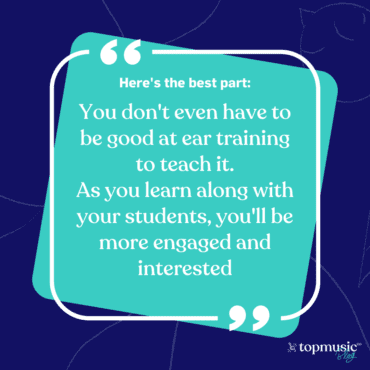
Ear training for piano can be targeted to focus on different musical elements. We can divide it roughly into melody and harmony. For this post, we’re going to stick with melody, which can be further divided into pitch and rhythm. We’ll begin here with pitch.
This simple game for beginners will have a surprisingly profound effect on your own tonal perception.
Once you have taught your first major scale, simply play up the scale and stop on a note. At first, the student will count up the scale, and tell you (or, even better, sing to you) what number you stopped on.
Begin with one scale, but then transpose the exercise around to different scales.
But that number isn’t just a number: it’s a scale degree. And learning to hear scale degrees does wonders for your perception of the movement of melodic phrases and later chords.
That number also indicates the interval from the tonic
Once your student has mastered ascending scale degrees by number, repeat the same exercise with the solfa (aka solfege) syllables: do, re, mi, fa, so, la, ti, do. These solfa syllables are easy to sing and foster profoundly intuitive connections with the inner structures of music.
Now repeat the same game, but play your scale descending from the tonic. Remember that, once your student has mastered one scale, it’s important to change around to different scales.
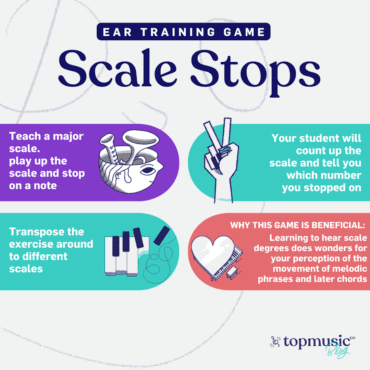
… Literally! Rather than asking your student to sing the note you stopped on, have them sing and name the next note (ascending or descending, depending on your direction).
Gradually introduce pitches at different intervals from the tonic without the other scale steps. At first, have the student sing up the scale to the goal note. Before long, both of you will be recognizing scale degrees, solfa syllables, and intervals without playing the in-between notes.
Intervals are the most basic building blocks of ear training. Yet endless interval drills can be quite boring and difficult. One of the advantages to Game 1: Scale Stops is that the intervals are placed firmly within the context of the diatonic scale, giving them much more meaning and significance.
However, being able to identify intervals in and of themselves can help your ear navigate through intervals within the scale, modulations, and less tonally-centered music.
As a creative piano teacher, your sensitivity to your student’s learning curves can exponentially increase your student’s learning efficiency and fun factor.
The key is to start with success and build on it slowly.
Begin with two intervals. Major seconds and major thirds are a good place to start, since most piano methods introduce ‘steps and skips’ early on. As you play them for your student, you’ll be able to see where the stumbling places are and reinforce the learning in subtle ways with nonverbal cues – mirroring the emotional contrast between the intervals with exaggerated facial expressions, etc.
Tritones and minor seconds offer wonderful opportunities for exercising your comical facial contractions.
If your students have the skills, change places and let them play the intervals while you guess. They will thoroughly enjoy stumping the teacher!
Keep it light, keep it fun, and keep it short. Whether or not your students practice these in between lessons, you’ll be surprised how much they retain.
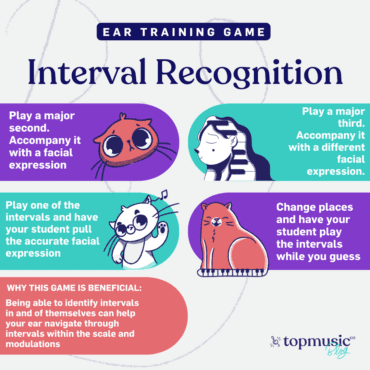
This game builds on interval recognition, and can be modified to utilize solfa syllables or scale degrees.
You’ll need two instruments (a piano and a keyboard, or a keyboard app, work just fine). Even better, take turns at one piano – which means you’ll both be getting up and down, introducing some much needed motion into your normally sedentary piano lessons.
Tell the student what note you’re starting on, then play another note. Then your student listens (no peeking!) and echos the first note and the new note. One guess – no poking around for the second note!
If the student guesses wrong, you repeat the same notes until she answers correctly.
Then it’s her turn. She takes the last note played, and plays another – now it’s your turn to guess!
Even though the one player repeats the notes until the other can play them correctly, the one guess at a time rule is very important: it raises the stakes, serves to keenly focus attention, and builds aural memory.
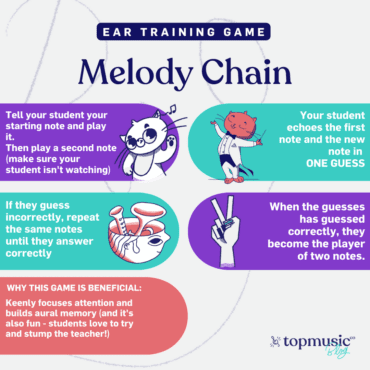
Students love to stump the teacher by using huge intervals. With 88 keys to choose from, this game can quickly get out of control – and become severely reduced in its usefulness. I highly recommend that you set some rules and limits to enhance and concentrate the learning. Feel free to combine these and/or change these up depending on what your student most needs to learn in the session:
The best thing about this game is that it is portable and adaptable. Given the chance, enthusiastic students are more likely to play it with their siblings and peers.
Rhythm combines with pitch to create melody. So many of our students confound us with their rhythm issues. A student who can echo back a complex syncopated pop rhythm by ear can’t keep quarter notes and half notes straight on the page. Another reads 4/4 time perfectly well, but can’t play 3/4 time without adding an extra beat to the measure.
As we search for ways to help our students master rhythm, it’s important to remember that feeling rhythm, reading rhythm, and playing rhythmically are three separate things. Ear training games can help us in all these areas.
The practice of measuring music into equal beats is not universal. For example, western musicology has translated the unequal accents of Balkan dances into 7/8 or 11/8 – meters that feel very awkward to read and play, but make perfect sense to the bodies of the dancers. A very large percentage of popular music places divides what Western music would call a 4/4 measure into a 3+3+2 pattern (♩. ♩. ♩).
Many people hear rhythms correctly according to these innate ratios, but do not internally measure them by the beat, which is the foundation of our Western rhythmic and metrical notation system. So our students are often “pulled” off beat in their attempts to play the rhythms they hear.
Simple clapping games – clapping along with recorded music or, even better, while you are playing the piano for them – will soon reveal whether your student feels the beat.
Begin with simple 4/4 tunes. Then teach your student to accent on 1 and 3 (with most classical and traditional music), and then 2 and 4 (with much popular music). Add syncopation and challenge your student to connect with the steady pulse that lurks below the off-beat rhythmic accents.
Alternately, have your student clap the rhythms while you clap the beats.
Vary these games with different rhythmic motions – playing a piano key or chord, marching, tapping a nose or pulling on alternating earlobes… keep it fun and varied. And alternating right and left helps the student to feel the difference between 1, 3 and 2, 4 in a very organic way.
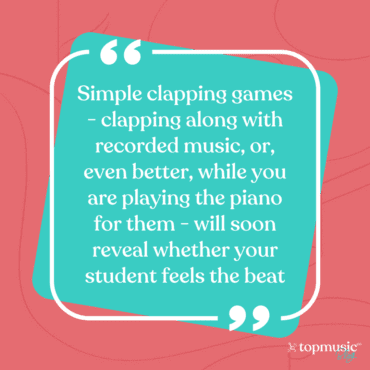
I believe it is safe to say that we have some students who have never heard music in triple meter. 4/4 reigns as the absolute rhythmic monarch in today’s pop music. Similar clapping games – even teaching your student to waltz – can lead to that ah-hah moment as you “discover” triple meter together.
Most students can imitate rhythms by ear surprisingly well – even those who have difficulty reading rhythmic notation, or who lack a clear sense of the beat. Since we are surrounded by syncopated rhythms that feel great but may be a nightmare to read, students are often capable of playing with much greater rhythmic complexity than they are able to read.
Traditionally that has kept piano teachers from helping students learn to play the music they really love.
It really is okay to set aside the ‘need to read’ and teach your students rhythms by ear. This can be really fun to do spontaneously with clapping and other imitation exercises in the course of learning a particular song. Once students understand by ear what the rhythms sound like, they begin to associate these sounds with what they see on the page, passively and gently improving their sight reading.
Another way to build ‘rhythm ears’ and rhythmic memory is a rhythm chain game, similar to Game 3: Melody Chain. Clap or play a short rhythm. Your student imitates and claps his own. You imitate his, and add another short segment.
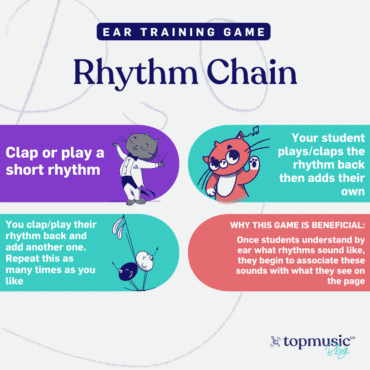
Alternatively, you can challenge your rhythmic memory by remembering and clapping all the rhythms back to the beginning. Be encouraging and helpful – not competitive! – and see how far you can go together.
For many years, the traditional focus of piano teaching has been on reading music. But when as a child you learned to read, you learned to write at the same time. Transcribing rhythms introduces that active writing component that has long been missing from music education.
Students love rhythmic dictation! Keep your sessions short, simple and successful, focusing on particular problem areas. You’ll be surprised how a student who can imitate and play complex syncopations can be confused by simple quarter notes and half notes. And then see what happens when you throw in quarter rests!
Usually two measures of 4/4 or 3/4 are plenty to give at a time. You can use it to solve a particular one-time issue, or practice it over a long period of time. Either way, you’ll be surprised at how well your students retain what you’ve worked on, especially when rhythmic dictation is seen as a surprise and a treat.
As creative piano teachers, many of us work hard to wean ourselves and our students from the “need to read”. But mastering rhythmic notation has undeniable benefits when it comes to understanding rhythm in a really deep way.
The ‘Kodály’ syllables are to rhythm what solfa is to pitch. Music educators have developed several variations on these syllables, along with various lyrical variants (e.g. the Suzuki classic “pepperoni pizza”). The advantage over the old “count chant” (1 + 2 + … ) is that these are easy to say and more intuitive.
Read more about the music education genius and legacy of Zoltan Kodály and how Kodály ear training tools can expand your creative piano teaching.
‘Speaking rhythm’ internalizes beats and subdivisions in much the same way as our written note values, and as such becomes a helpful precursor to dictation. Syllables and lyrics can be substituted or added to Game 5: Rhythm Chain and Game 6: Writing Games.
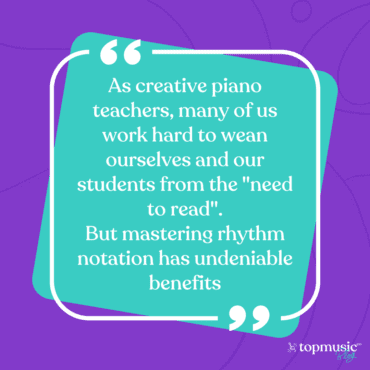
These games grew organically out of my own creative piano teaching, and desire to further the musical goals of my own students. They emerged through trial and error, experimentation, inspiration, intuition, and even from frustration. Some of them have become long-term staples, others arose to address the needs of the moment.
In fact, though we all recognize the benefits of regular ear training, it has repeatedly surprised me how even one session can make a permanent difference in helping a student to grasp a new musical understanding.
Many of these games can be adapted to chord quality and chord progression ear training as well. Or invent your own games for harmony training.
Accordingly, I strongly encourage you to maintain a playful attitude with them. Modify, adapt, invent, and always remember, you don’t have to know everything before you teach. Your own enthusiasm for learning will delight and inspire your students.
As well as helping your students become musicians who can listen as they play, ear-training games help with giving students an exciting musical opportunity. Playing by ear.
Students who have worked on their ear-training skills and improved their ability to repeat melodies and rhythms are prepped and ready to start playing their favourite songs by ear. Through these fun games and activities, they now have the skill and confidence to listen to a son, pick it apart, and figure out how to play it without the need of sheet music.
If you’d like more tips on helping students play pieces by ear, TopMusic has the course for you! “Teaching Popular Music By Ear with Simon Rushby” is available to all Studio and Evolution members of TopMusicPro.
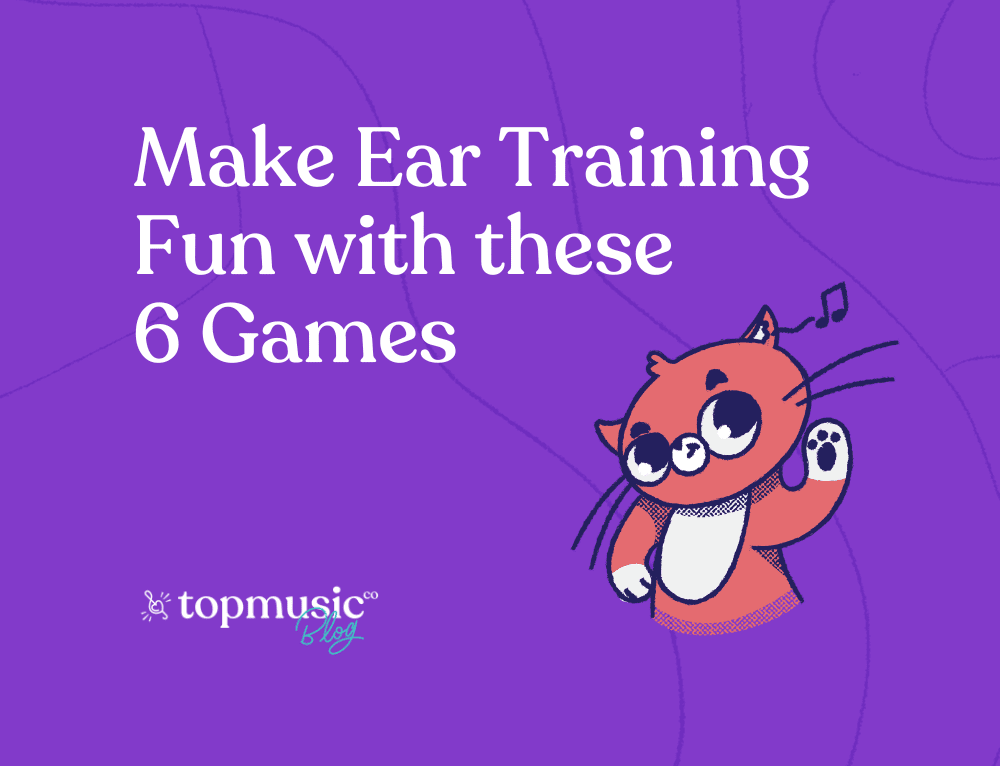
Kim Oien says:
I will be using one or more of these games in my upcoming class right before Christmas. For the descending scale in Scale Stops I can use Away in a Manger or Joy to the world since their first phrase is just that! Thanks for the great ideas!
Andrew Bishko says:
That’s perfect! Christmas is a great time for ear training and playing by ear since there are so many melodies to pick from that are so familiar to our students.
Heidi says:
I love the idea of scale stops and your step by step instructions! I came looking for group piano ear training ideas and this post sparked the idea of doing interval recognition as a group. Students could perform a motion that matches the beginning intervals of familiar songs. For example M2 London Bridge – make a bridge with arms, M3 Oh When the Saints – march 3x, P4 Here Comes the Bride throw rice in the air 4x, etc.
Andrew Bishko says:
Great ideas, Heidi! I’m inspired by your creative thinking!
Janet says:
Super awesome ideas for ear training!
Can’t wait to implement them in my studio! Thank you so much for sharing 🙂